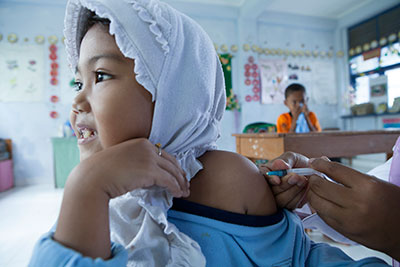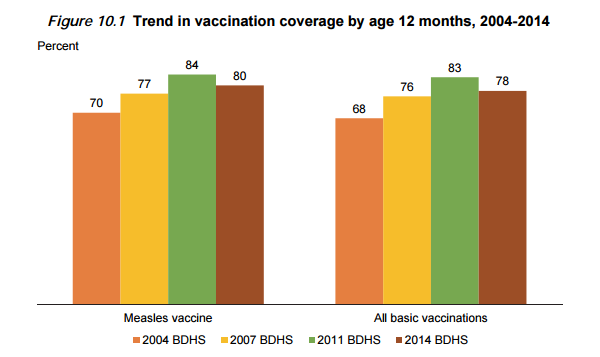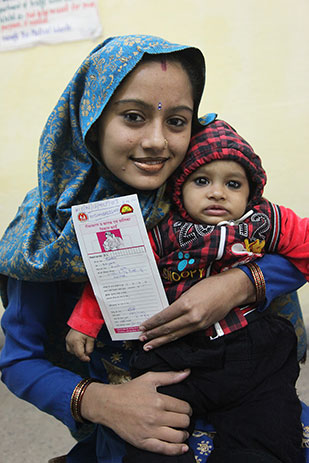The Vaccination Landscape: Changes and Challenges
What was the last vaccination you received? The one before that? When did you receive them? Where was the vaccine administered – your arm? Your thigh? The right or the left? For most of us, this is not easy information to remember. And yet it’s what we ask many women to recall for their children in DHS interviews.

© 2012 Armin Hari/INSIST, Courtesy of Photoshare
Since 1984, The DHS Program has collected data on vaccinations in over 80 countries. During this time, the vaccination landscape has changed dramatically. Initially, BCG, DPT (Diphtheria; Pertussis, or whooping cough; and Tetanus), Polio, and Measles were the only childhood vaccines most countries administered. These data were collected only from vaccination cards.
As time went on, our methodology expanded to include data collection from mother’s recall to clarify incomplete vaccination cards. In cases where there is no vaccination card, mothers are asked whether or not her child received each type of vaccine and the number of doses.

2014 Bangladesh DHS (BDHS)
Today, the number of vaccines standardly administered is much higher. This is good news — it means millions more lives saved — but it introduces data collection challenges.
The vaccination data collected in a standard DHS questionnaire are far more elaborate than any time in our history: BCG remains; for Polio a birth dose is added; DPT is now combined into a pentavalent vaccine with Hepatitis B and Haemophilus influenza type B (Hib); 3 doses of a pneumococcal vaccine and 3 doses of a rotavirus vaccine are now included; and the measles vaccine has been replaced with a measles combination vaccine. For countries that are transitioning between vaccination schedules or have more complicated schedules, the landscape becomes more challenging to navigate.
Data collection is relatively straightforward when a child has an up-to-date and complete vaccination card. But in many cases, changing vaccine schedules and inconsistent record-keeping render the cards incomplete or unclear. Worse, vaccination cards are often missing or otherwise unavailable.
Indeed, a recent study revealed that in 4 of the 10 countries with the largest birth cohorts that had carried out either a DHS or MICS survey in 2010-2013, less than 50% of children had home-based vaccination records.

© 2012 Bhupendra/MCHIP, Courtesy of Photoshare
When a vaccination card is unavailable, it is the mother who is expected to fill in the gaps. But a mother’s recall is not 100% reliable. Keeping track of vaccines for multiple children and for combination vaccines is challenging enough, but even more so if the mother isn’t present for every vaccination event.
Knowing whether newer and existing vaccines are reaching their target population and doing so on schedule is valuable information to many. What can be done to maintain and even improve data quality when the complexity of the data needs on vaccine coverage continue to grow?
The DHS Program, in collaboration with the World Health Organization (WHO), United Nations Children’s Fund (UNICEF) and other experts in the field, are pursuing several options. One involves visiting health facilities to compare the information collected during the interview to the vaccination information recorded at the health facility.
This process has been used previously in Central Asian countries and in Albania, where facility-based documentation is strong. It is now being pilot-tested in Ethiopia; however, the method of record-keeping varies by location and includes instances where records are kept based on the date of visit and not based on the child’s name or date of birth. Country-specific challenges such as these require additional flexibility and coordination between survey implementers, Ministries of Health, and health facilities.
There is unlikely a one-size-fits-all solution to the challenge of accurately measuring vaccination coverage. But from the perspective of global health, this is a good problem to have. More children worldwide are being protected from a host of illnesses. We are proud to be sharing data to help track progress towards closing the gap as our implementing partners reach more children with a larger variety of vaccines.



The problems in measuring vaccination coverage is very common in most of the country where cord are not available at the time of survey. I am interested to know to what extent vaccination had controlled the mortality and increased the survival of children under five years of age. What are major challenges and how to tackle.